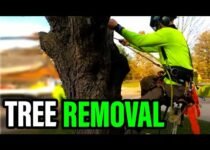Different Methods of Tree Removal
If a tree on your property has become damaged or unhealthy, you may want to consider having it removed. Tree removal is a difficult task that should be left to professionals. It can be dangerous, especially if it isn’t done properly. There are several different methods of tree removal, and each one requires special equipment and knowledge. If you’re considering doing it yourself, it’s important to understand what goes into the process so that you can safely and effectively remove a tree from your home or yard.
Tight spaces
When a tree is located in close quarters, it can be more challenging to remove it. Tight spaces include backyards with narrow fence setbacks, crowded urban neighborhoods, and small areas between buildings. These spaces can be dangerous for crews using large equipment and can put surrounding structures at risk of damage. This type of work requires specialized knowledge and skills, and it’s usually more expensive than removing a tree in an open space.
Notching
Notching is the most traditional way to remove a tree, and it’s often considered the safest option. This method involves cutting a right-angle notch into the trunk of the tree at a point that’s 10 feet or more above the ground. The notch should be facing the direction you want the tree to fall. You’ll also need to clear the area around the tree of tripping hazards, wires, and other objects that could get caught in the fall.
This method isn’t the best option for trees near houses or other structures, as it can cause severe damage if not done correctly. If you’re removing a tree that is precariously close to your home, it’s best to contact a professional for assistance. A trained arborist will assess the tree’s condition and determine whether it should be felled.
Stumps
A common issue is leaving behind an unsightly stump after a tree has been cut down. This can be a big eyesore and a tripping hazard. There are a few different ways to remove a stump, including digging it out or pouring chemical stump killer into the hole. Digging out a stump can take weeks and requires special equipment. Chemical stump killers can be poured into the hole and will usually kill the roots within a few months.
If you’re removing a tree from your own property, it’s a good idea to plan an escape route in advance. Choose a primary and secondary path to run down if the tree falls the wrong way. A professional will inspect the tree for signs of leaning or other problems, and they’ll be able to predict how the tree will fall based on its current health and conditions. This allows them to make sure that it won’t fall into your house, car, pool, power lines, or other nearby structures. A pro will also be able to ensure that the tree falls where it should and not into your neighbors’ properties. They’ll also use a crane to remove the tree from your yard if necessary.


